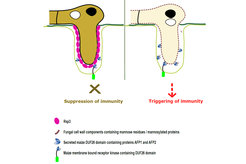How a fungus protects itself from the hostile environment faced after infecting maize plants
The fungus Ustilago maydis causes maize smut disease. When infecting maize plants the fungus is recognized through the plant immune system which attacks the intruder through a cocktail of defense molecules. Scientists from the Max Planck Institute for Terrestrial Microbiology in Marburg have uncovered a new mechanism that allows the fungus to protect itself from the anti-fungal activity of two proteins present in this cocktail. They show that these maize proteins do not only attack U. maydis but also other fungal pathogens that parasitize maize. Their finding provides novel insights into the amazing interplay between a pathogen and its host and offers new leads for disease intervention.

To invade a plant successfully and cause disease, U. maydis secretes several hundred effector proteins, which suppress plant defense responses and reprogram development and metabolism of the host to meet the needs of the pathogen. Most effectors are novel molecules that rarely contain known motifs. To understand how effectors contribute to fungal accommodation in the host tissue and allow disease progression, it is necessary to elucidate their biochemical function. One of these novel effectors is Rsp3, a very unusual protein whose C-terminal half consists of a complex array of several different repetitive units. In field isolates, rsp3 shows strong length polymorphisms resulting from deletions and rearrangements in this repetitive domain. rsp3 is highly expressed during colonization and when the gene is deleted virulence of the fungus is strongly attenuated. By immunostaining of infected plants, Rsp3 was detected exclusively on the surface of hyphae. Biochemically, Rsp3 was shown to interact with two secreted maize DUF26 domain-family proteins designated AFP1 and AFP2. These proteins are related to a mannose-binding antifungal protein from Ginkgo biloba. AFP1 protein could also bind mannose and displayed antifungal activity against the rsp3 mutant but not against an U. maydis strain decorated with Rsp3 protein. In maize plants in which the expression of the AFP1 and AFP2 genes was silenced, the virulence defect of rsp3 mutants was alleviated. This shows that blocking the antifungal activity of AFP1 and AFP2 by the Rsp3 effector is an important virulence function. Rsp3-related proteins are present in all smut fungi suggesting a novel widespread fungal protection mechanism. Interestingly, it could also be demonstrated that maize plants silenced for AFP1 and AFP2 become more susceptible to the fungus Colletotrichum graminicola causing anthracnose stalk rot and leaf blight in maize. This reveals that the antifungal maize proteins discovered in this study play a more general role in restricting growth of plant-infecting fungi.
Publication:
Ma, L.-S., Wang, L., Trippel, C., Mendoza-Mendoza, A., Ullmann, S., Moretti, M., Carsten, A., Kahnt, J., Reissmann, S., Zechmann, B., Bange, G. and Kahmann, R. (2018)
The Ustilago maydis repetitive effector Rsp3 blocks the antifungal activity of mannosebinding maize proteins
Nature Communications 9:1711
doi: 10.1038/s41467-018-04149-0





![<p>Discovery of [Fe]-hydrogenase in bacteria opens new possibilities for conversion of hydrogen</p>](/506336/original-1555497672.jpg?t=eyJ3aWR0aCI6MzYwLCJoZWlnaHQiOjI0MCwiZml0IjoiY3JvcCIsImZpbGVfZXh0ZW5zaW9uIjoianBnIiwib2JqX2lkIjo1MDYzMzZ9--d3d7c57e064104c2acc573916156127d6bedd85b)


![Protection of [Fe]-hydrogenase](/416905/teaser-1561027823.jpg?t=eyJ3aWR0aCI6MzYwLCJoZWlnaHQiOjI0MCwiZml0IjoiY3JvcCIsImZpbGVfZXh0ZW5zaW9uIjoianBnIiwib2JqX2lkIjo0MTY5MDV9--6ea496a03c86ba3d98a19e05aac63809917fe800)



